What Is the Lower Paleolithic and Its Stone Tool Traditions
Here you can have a look at a piece on human prehistory in early Paleolithic. It provides an answer when was the lower Paleolithic era and describes the most widespread stone tool traditions of that period. Although this is the second part of the bigger study, it could be similarly viewed as separate scientific work. The thing is, with the best essay writing help of our experts, crafting both huge and smaller research papers will be a breeze for you!
The Lower Paleolithic
This article is divided into parts:
- Part I: General context of human life in the Paleolithic
- Part II: The Lower Paleolithic (this part)
- Part III: The Middle Paleolithic
- Part IV: The Upper Paleolithic
The oldest period of the Paleolithic is the lower paleolithic, which began approximately 2.6 million years ago, with the start of the Quaternary, and ended as recently as 100,000 years ago. This is by far the longest span of human history, representing over 95% of the time that hominids have existed on Earth. The stone age or "lithic" age all together accounts for over 99% of the time humans have been on Earth. As recently as 5,000 years ago, most of the world was essentially living in the stone age, using stone tools.
Lower Paleolithic
The beginning of the Paleolithic is marked by the earliest stone tool industry, which is associated with the appearance of Homo habilis, although it is possible that late Australopithecines made stone tools as well. The earliest stone tools were made by the process of knapping, or flaking, in which one stone is repeatedly hit by another object (which may be another stone, bone or antler) in order to chip off flakes and bring the stone to the desired shape. The best rocks for knapping tend to be hard, fine grained or amorphous rocks, such as flint, chert, obsidian, quartz, and hard shale.
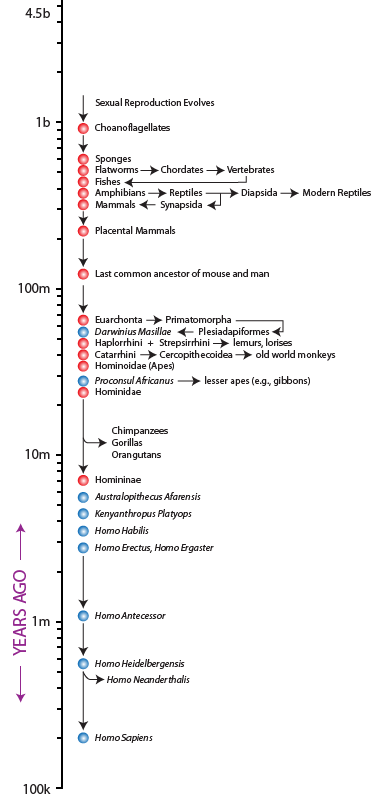
We know of this industry because of the artifacts it leaves behind. These include the cores (parent rock from which chips have been flaked), flakes (the chips removed from the parent rock), as well as hammer stones or percussors which were used to do the knapping. Sometimes, cores are modified later by retouching: removing finer chips from the edges to create sharper edges or points (retouched tools).
All of these artifacts can be present at a given archeological site. The problem sometimes is being able to distinguish rocks which have been shaped by humans from those shaped by natural processes. It is not always easy, specially for the oldest tools, which have been fractured and damaged over time. Modern methods of microscopic analysis which look for wear and tear patterns can help distinguish stone tools from natural artifacts.
The lower paleolithic has at least 3 different tool traditions, identified by specific locales where their remains are found. They include:
Oldowan Industry
Oldowan tools were first found in the Olduvai Gorge in Tanzania by Louis Leakey in the 1930's. The Oldowan industry takes its name from the Olduvai Gorge (the "Type" site), and dates back about 1.85 million years in that area. However, even earlier Oldowan type tools (dating to 2.6 million years) have now been found in Ethiopia. This was at Gona, in the Afar Triangle, the same area where the fossil of Lucy and other Australopithecines were discovered. The second oldest site for the Oldowan tradition is the Omo River basin, also in Ethiopia, where the industry dates back to 2.4-2.3 million years. Sites in East Turkana (Koobi Fora) date back to at least 1.9 million years. In South Africa, Sterkfontein dates to as early as 2 million years, while Swartkrans dates to about 1.85 million years at the earliest. These are just some of the sites so far discovered, there are probably many more remaining to be discovered. In general, it appears that Oldowan industry appeared somewhere in east Africa some time around 2.6 million years ago, and spread to regions further south from there.
The Oldowan industry is more properly a tool making tradition, not a culture. It was probably used by many cultures in many different areas, by different hominins, from Australopithecus to Paranthropus to early Homo, as a very simple tool industry. Early literature refers to the first tool users as Homo habilis, or "handy man". This is probably wrong. There were many hominin species present at the time, including australopithecines. Even our small sampling of fossils have shown many different phenotypes that have been classified in various hominid or australopithecine species, all living in east Africa around 2.6 million years ago. The true number was probably even larger, since the fossil record is sparse.
It was the tendency of earlier investigators to pick the most modern looking species of the lot and ascribe tool use exclusively to them, hence the belief that Homo habilis invented the first tools. There is little evidence for this view in the archeological record. It is more likely that many different hominin species manufactured and used simple tools. Even chimpanzees today can be taught to flake tools. It's possible that industries older than the Oldowan exist, which have not yet been discovered. The family Homininae has been around for 7 million years (chart on right), and it's possible that many earlier species also used tools.
Oldowan tools are classified as choppers, scrapers, pounders and awls, since these seem to have been their apparent use. These are uses related to butchering meat, not acquiring it. So it does not appear that these tools found any extensive use in hunting. Tools are typically produced by a process of lithic reduction, where a stone core is pounded with a hammer stone (or bone or antler) to produce fractures, chipping away flakes which are discarded or made into flake tools.
The earliest Oldowan tools (such as those found in Ethiopia) are sometimes called pebble tool technology. This is because the stones used to make them were pebbles, probably picked up along river beds. They often retain their water-worn pebble shapes after minimal chipping. Many of the older tools are very simple cores, with a minor amount of flaking.
Hypothesized uses include cracking open nuts and bones (pounders and choppers), scraping hides, digging for roots, or for shaping wood or antler to create tools out of those materials. This is not purely guesswork, since modern researchers have recreated these tools and subjected them to such uses. Microscopic patterns of wear and tear on the tools match those found in actual tools recovered from archeological sites.
It's interesting to note that most manufacturers of Oldowan tools were right handed. Lateralization of function had therefore evolved in hominins by that time. It is not clear how far this lateralization went in regards to brain function, i.e., it would be wrong to conclude that modern ideas associated with "left brain" and "right brain" function had any counterpart at the time.
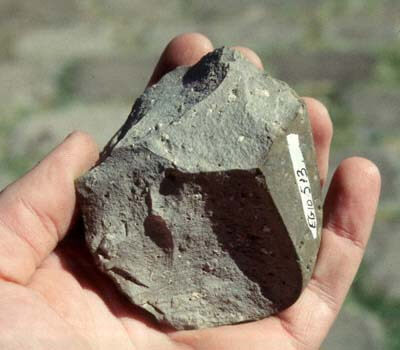
One of the oldest known tools: a chopper found at Gona, in Ethiopia, is 2.5 million years old.
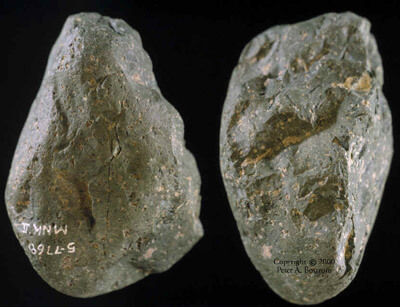
A chopper found in Olduvai Gorge in Tanzania. This tool is about 1.85 million years old.
The first hominid to leave Africa was Homo erectus or Homo ergaster (early Homo erectus is sometimes called Homo ergaster in Africa), who starting emigrating from Africa probably some time soon after 2 million years ago. Homo erectus took the Oldowan tradition with him to the middle east, Asia and Europe. None of the earlier hominids or australopithecines are found anywhere outside Africa. Some of the early sites outside Africa which show evidence of habitation by Homo erectus include:
- Riwat, Pakistan: Oldowan tools as early as 1.9 million years old, one of the oldest non-African sites.
- Dmanisi, Georgia: Oldowan tools and a nearly complete skull 1.7-1.77 million years old. The earliest clear evidence (from the skull) of Homo habilis/ergaster outside Africa.
- Erq-el-Ahmar, Israel: Oldowan pebble type tools, 1.8 million years old.
- Lenggong, Malaysia: Oldowan type tools, 1.83 million years old
- el-Ubeidiya, Israel: Oldowan tools dating to at least 1.5 million years ago
- Xiaochangliang, China: Oldowan tools, 1.36 million years old.
- Orce Ravine, Spain: Oldowan tools, 1 million+ years old.
Note that these dates are not universally accepted. This is ongoing work and some of these dates may turn out to be wrong.
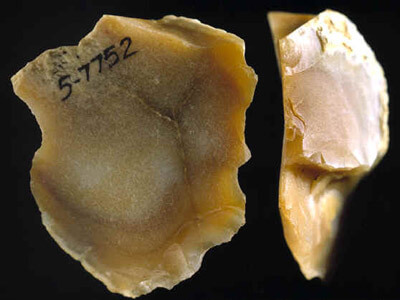
A flaked tool made of chert found in Olduvai Gorge, around 1.7 million years old. Tools like this were used as scrapers.
Most Oldowan sites, specially in Africa, are found near rivers or lakes, suggesting that the tool makers preferred to live near a source of water. Analysis of the tools and nearby rock formations shows that the rocks used to make the tools were often transported over distances of several kilometers. Some sites are quite extensive, containing thousands of stone tools and detritus from the process of creating them, and animal bones representing thousands of animals. It is a matter of debate whether these early humans were hunters or scavengers, but it seems certain that meat formed a significant portion of their diet (many of the tools seem specifically designed for the butchering of meat, cleaning of hides, etc.), and that they transported hunted or scavenged animals to their camps for consumption. Other items in their diet probably included roots, tubers, berries, fruits and flowers.
Oldowan industry lasted for a very long time, for a period of 2 million years, from 2.6 to 0.5 million years ago. Therefore, it co-existed with later tool traditions for a significant period, sometimes in the same geographical region. During the early part of the Oldowan, this may have something to do with the number of species of hominids and australopithecines around, possibly with different species using different industries. However, only hominids have been around for the last million years or so, therefore even populations that we recognize as likely being a single species, such as Homo erectus, used different industries in different parts of the world. Specially in east Asia (China and Java), the Oldowan industry seems to have lasted as late as half a million years ago. In Africa, western Asia, the middle east and Europe, however, the Oldowan industry seems to have been replaced by other traditions by 1.2 million years ago.
Acheulian Industry
The Acheulian industry is named after the site Saint-Acheul in France, where artifacts of the industry were first discovered. The earliest examples of Acheulian material come from West Turkana in Africa, and are about 1.65 million years old. Recently, scientists have extended the Acheulian back even further to 1.76 million years ago. The Acheulian industry marks a significant development in the evolution of the human brain, and is very likely associated with Homo erectus, and later, Homo heidelbergensis. The Acheulian industry lasted for a very long time, for over 1.5 million years, making it the longest industry in the history of mankind. The last Acheulian sites are about 100,000 years old.
Acheulian tools were more sophisticated than Oldowan tools. The main difference was the bifacial nature of the tools, that is, they were chipped symmetrically on two opposite sides to create a thin cutting surface. For this reason, they are called "hand axes" and the Acheulian tradition is also called the hand axe tradition. Many tools were retouched - i.e., refined after the basic shape had been obtained, to sharpen the edge or to further improve the shape. This retouching was done with a softer hammer, probably a bone or antler hammer, rather than the hammer stone used to create the basic shape.
Acheulian tools are also larger, with larger cutting edges. The average cutting edge of an Acheulian tool is about 8 inches, compared to about 2 inches for comparable Oldowan tools. Acheulian tool makers also used older Oldowan type techniques, and in many places tools created with both technologies are found together. Acheulian tools are geographically very widespread, reflecting the extent of colonization by Homo erectus. Interestingly, the hand axe tradition is found in Europe, the middle east and India, but not in southeast Asia.
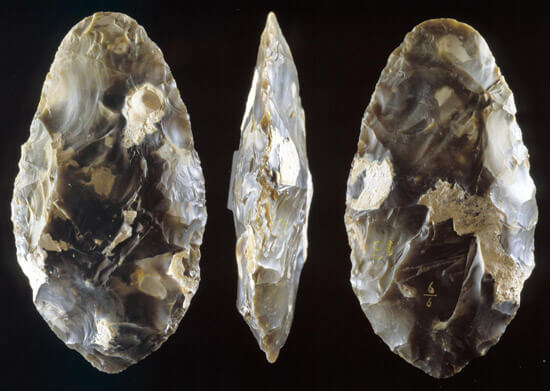
A classic Acheulian hand axe, from Saint Acheul in France. About 350-300,000 years old. Note the bifacial symmetric chipping, to create an edge that narrows from both faces. These are the commonest Acheulian tools.
Some sites, primarily in Africa, have collections of hundreds of very large hand axes. Many of them are too large to be practical, and some show no signs of use. These sites are between 0.9 - 0.6 million years old. The purpose of such large collections of apparently useless axes is not well understood. It seems to indicate that the axes served some purpose beyond the utilitarian. If they were ceremonial or social objects, it would seem to have implications about the complexity of their societies and the individual's capacity for abstract thought. The symmetry of the tools has also been used to argue that these people had the capacity for language, since the areas of the brain responsible for fine motor control are very close to the speech areas. This is a matter of debate. Some of the earliest evidence of purpose-built human dwellings, such as at the Terra Amata site in France, also come from the Acheulian.
Since the range of the Acheulian is so vast (1.5+ million years), there is significant variation across time as well as geography, and attempts have been made to sub-classify this period. There are local transitions in technology but none appear to be very major.
The one exception is in Africa, where tools made before about 600,000 years ago appear to be rougher and cruder than those made after that period. Since this is roughly when Homo heidelbergensis first differentiated from older types of Homo erectus, there is speculation that the newer and more refined industry was the work of Homo heidelbergensis.
The transition of Homo erectus into a more modern form during the middle Acheulian is clouded in debate, because of the scarcity of fossils. The Gran Dolina site in Spain is one of the earliest evidence of hominids in Western Europe. The oldest skeletons found there have been dated to 850-780,000 years old, and they have been classified as a new species, Homo antecessor or Homo mauritanicus (same thing, different name). This appears to be a transitional form, between classic Homo erectus and the more modern Homo heidelbergensis. These bones are also remarkable for showing the first evidence of human cannibalism, as about a quarter of the bones have distinct markings indicating the use of stone tools to slice flesh from the bones, and the crushing of bones to extract marrow. Some people have suggested that Homo antecessor may be more related to eastern Asian (Chinese) variants of Homo erectus than to Homo heidelbergensis. If this is true, then the role of Homo antecessor as a direct ancestor of humans becomes murkier. Most people generally agree that modern humans, as well as Neanderthals, are descended from Homo heidelbergensis.
Homo heidelbergensis was first identified through a specimen of a jawbone found in Germany (and characterized by a professor at Heidelberg). Many other specimens have been found across Europe, including "Boxgrove Man" in England (524-478,000 years old) and at Sima de los Huesos in Spain (350,000+ years old). At the same time, fossils of a comparable age are found in Africa. The best examples are from Rhodesia, leading to the name Homo rhodesiensis. It is thought that Homo heidelbergensis and Homo rhodesiensis are the same species, which probably first appeared in Africa about 600,000 years ago.
There is some controversy here though. The older fossil remains of Homo heidelbergensis (and Homo rhodesiensis, if they were indeed the same species) are found in Europe, not Africa. The oldest African examples of this type are around 300,000 years old, while the European examples may be up to 500,000 years old. There may be several reasons for this. One likely reason is simply chance. Human fossils are rare, and it may simply be that older fossils exist in Africa but have not been found. The sudden, sharp change in Acheulian stone industry found in Africa, which has been convincingly dated to 600,000 years old, seems to argue that some significant change occurred in Africa at the time, and one way to interpret this is as the emergence of Homo heidelbergensis. The other factor is that genetic evidence seems to point pretty unambiguously to Africa as the source of all modern humans (see Recent Out of Africa Model). So it's clear that modern humans did first evolve in Africa. But since Homo heidelbergensis is the closest ancestral form to us in terms of phenotype, then it seems likely that it was directly ancestral to us. So we are left with the fact that we evolved from Homo heidelbergensis in Africa, even though our oldest known specimens of Homo heidelbergensis are from Europe. The sparser explanation is that older fossils of Homo heidelbergensis exist in Africa, but we haven't found them yet. The alternative would be that Homo heidelbergensis evolved outside Africa, then returned to Africa to evolve into Homo sapiens, who then left Africa again. This is a more complex theory, and no direct evidence of it exists. There does, however exist indirect evidence that some change came to hominids in Africa around 600,000 years ago, precisely when Homo heidelbergensis would have first evolved. Future discoveries will settle this question.
Besides the more refined stone tools associated with Homo heidelbergensis in Africa, several other "firsts" are associated with this precursor to modern man. The oldest custom built dwelling (as opposed to natural caves which were used and possibly excavated/deepened by earlier humans) were made by Homo heidelbergensis. The Terra Amata site in France has the remains of what may be one of the oldest human custom built dwellings. Based on stones found at the site, people have conjectured that they are the remains of hut-like dwellings which could have held 20-40 people. There is some evidence of even earlier structures. Post holes found in Chichibu, Japan, indicate that Homo erectus may have built shelters as far back as 500,000 years ago.
There is some evidence (again from Gran Dolina in Spain) that Homo heidelbergensis may have buried his dead, though this is contested. Their ear anatomy shows that their hearing sensitivity was very close to that of modern humans (and quite unlike that of chimps). They would certainly be able to appreciate the finer modulations of human speech, though of course, this is not evidence that they had language. A number of wooden projectile spears were found in Schöningen in Germany, which have been dated to 400,000 years old. These were likely produced by Homo heidelbergensis, though we can't definitely rule out Homo erectus, who was also around at the time. Wooden spears seem a likely indication that hunting was a significant part of their lifestyle. Finally, Homo heidelbergensis had a larger brain case than Homo erectus, which shows that he was more like modern humans.
The Acheulian tradition gave way to the Mousterian tradition of the middle stone age, about 300,000 - 250,000 years ago, though in some places it may have survived as late as 100,000 years ago.
Clactonian Industry
The Clactonian is a tradition represented by the type site at Clacton-on-Sea, in Essex, England (remember, England was connected to France at the time through a land mass in the English channel). It represents a tool making tradition that has been dated to as early as 400,000 years ago, until about 200,000 years ago. It therefore overlaps the Acheulian.
The reason for differentiating it from the Acheulian is the complete absence of the key innovation of the Acheulian - the hand axe. Initially, it was argued that:
- the sites found were not typical, perhaps they used hand axes, but they were simply absent from those sites,
- that hand axes were not needed in all locales, and this particular environment had no need for them,
- that materials for making hand axes were not locally available.
However, these theories were shot down by the discovery (in 2004) of a Clactonian site with a butchered elephant, together with a large number of flint tools, but no hand axes. Since hand axes would be considerably more useful in butchering an elephant than the crude choppers present at the site, the argument of utility was not reasonable. Moreover, flint is an excellent material for making hand axes, so the presence of flint tools argued against the lack of suitable material. Finally, the increasing number of Clactonian sites with all sorts of tools but no hand axes makes it difficult to believe that hand axes were present at the time, but are absent from the archeological record. The simpler explanation appears to be that the Clactonian tool makers simply did not know how to make hand axes.
Clactonian tools are also differentiated from other Acheulian tools (and also from older Oldowan industry) by the presence of notches and grooves, which indicate that they were once attached to wooden or bone hafts. In fact, a preserved shaped wooden shaft has also been recovered from a Clactonian site. The tools are cruder than other Acheulian tools of the same period. The flaking appears to have been done by hard (stone) percussors, rather than softer bone/antler percussors which are better for finer work.
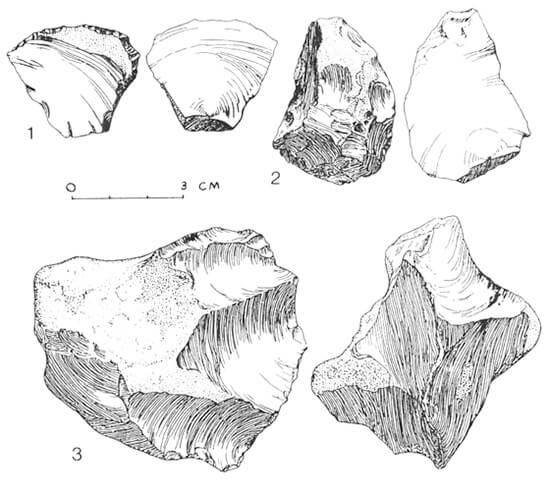
Drawings of Clactonian tools.
There are a few bifacials (but not hand axes) that some people associate with Clactonian sites, but the provenance of these items is in dispute. So there is no definite evidence that Clactonian tool makers knew how to make bifacial tools.
It was thought that perhaps Clactonian industry was a precursor to the Acheulian in the British isles, that the Acheulian arrived in there unusually late. However, the discovery of Acheulian sites (with hand axes) in England that predate Clactonian sites (such as the Acheulian site at Boxgrove, which is 500,000 years old) is a problem. It seems likely that Clactonian people had contact with Acheulian tool makers, so why they did not develop hand axe technology remains a mystery.
Acheulian and Clactonian industries were replaced at the end of the lower paleolithic by the emergence of Neanderthals in Europe, who created a more advanced technology, known as the Mousterian.
You may wish to review a general introduction to the paleolithic, or continue with a description of stone industries in the middle paleolithic.
If you're not after a Ph.D. degree, you hardly need such a profound work like the sample above. But the best thing about our service is that we can craft any type of assignment, and short ones too. So just reach out to us with your, say, 'Write my history essay for me' request, and we will surely come up with a top-notch paper!
Cite the page
- APA
- MLA
- Harvard
- Vancouver
- Chicago
- ASA
- IEEE
- AMA
If you want a unique paper, you can have one of our writers create it for you
Ours Services
Related Essays
Academic Essays Database Has All You Need to Succeed
- Essay
- Research Paper
- Case Study
- Report
- Critical Thinking
- Article Review
- Argumentative Essay
- Term Paper
- Literature Review
- Business Plan
- Research Proposal
- Creative Writing
- Cover Letter
- Dissertation Conclusion
- Dissertation Methodology
- Dissertation Proposal
- Dissertation Abstract
- Dissertation Hypothesis
- Dissertation Chapter
- Dissertation Results
- Dissertation Introduction
- Thesis
- Thesis Statement
- Business Proposal
- Biography
- Annotated Bibliography
- Admission Essay
- Movie Review
- Thesis Proposal
- Personal Statement
- Coursework
- Book Review



